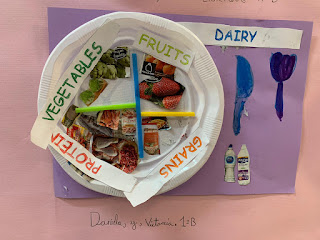Saint Patrick Day is a funny day that we celebrated at school. But,.. Why did we celebrate Saint Patrick Day?
Let me explain it!!
Saint Patrick's Day is a cultural and religious celebration held on 17 March, the traditional death date of Saint Patrick (c. AD 385–461), the foremost patron saint of Ireland.
Saint Patrick's Day was made an official Christian feast day in the early 17th century and is observed by the Catholic Church, the Anglican Communion (especially the Church of Ireland), the Eastern Orthodox Church, and the Lutheran Church. The day commemorates Saint Patrick and the arrival of Christianity in Ireland, and celebrates the heritage and culture of the Irish in general. Celebrations generally involve public parades and festivals, céilís, and the wearing of green attire or shamrocks.
Saint Patrick's Day is a public holiday in Ireland. It is also widely celebrated by the Irish diaspora around the world, especially in the United Kingdom, Canada, United States, Brazil, Argentina, Australia and New Zealand. Saint Patrick's Day is celebrated in more countries than any other national festival. Modern celebrations have been greatly influenced by those of the Irish diaspora, particularly those that developed in North America.
El Día de San Patricio es un divertido día que celebramos en el colegio. Pero, ..¿Por qué celebramos el Día de San Patricio?
¡Déjame que os explique!
El 17 de Marzo se celebra el día de Irlanda por antonomasia, el popular día de San Patricio que hoy en día -aparte de en Irlanda es celebrado en casi todo el mundo, y especialmente en Estados Unidos debido al origen irlandés de muchos de sus habitantes. Pero ¿qué hizo St Patrick’s para convertirse en el patrón del país?
Cuenta la leyenda que Patricio, nacido en Inglaterra en el siglo IV, pasó una triste infancia en la que fue forzado a trabajar en Irlanda como esclavo. Durante ese tiempo el joven desarrollo su interés por el cristianismo y, cuando consiguió regresar, fue a ayudar a los irlandeses y convertirlos al Cristianismo. Patricio así lo hizo, a pesar de todas las dificultades, y la leyenda cuenta que finalmente consiguió expulsar y salvar a los habitantes de las serpientes, metáfora que simboliza al santo librando a los irlandeses del paganismo, ya que en la tradición cristiana la serpiente representa el mal y al demonio, e improbablemente hubo serpientes en tales tierras.
Hoy en día St. Patrick’s Day es conocido por sus desfiles, especialmente en Nueva York, Boston, Nueva Orleans o Dublín -el original- éste similar a un desfile de Carnaval. Durante este desfile se pueden ver muchas personas mostrando los símbolos de su país y ataviados con algo de color verde, incluso mucha gente vestida de Leprechauns, esas pequeñas criaturas provenientes de los verdes bosques de esas húmedas tierras.
Hablemos un poco de esos símbolos ¿qué significan?
El trébol (‘shamrock’ en inglés) ha sido considerada una planta sagrada desde tiempos celtas, símbolo del renacimiento de la primavera. En el S. XVII comenzó a utilizarse como símbolo del nacionalismo irlandés y, debido a la represión sufrida en esos años por parte de los ingleses, los irlandeses comenzaron a llevar tréboles en su ropa como muestra de su orgullo y lucha contra la opresión británica.
Los Leprechauns. Estos pequeños seres pelirrojos forman parte del folklore irlandés se cree que también desde tiempos célticos, ya que estos creían en hadas y mágicos personajes con poderes que habitaban el bosque. El nombre original en irlandés el “lobaircin”, que significa “hombre de pequeño cuerpo”. Los Leprechauns eran seres cascarrabias y avariciosos, con gran habilidad para la picaresca y el engaño, responsables de arreglar zapatos a cambio de alguna moneda que ayudase a acrecentar su tesoro… escondido en una olla al otro lado del arcoiris.
Thanks Teacher Sonia for sharing this amazing video with us!
¡Gracias Seño Sonia por compartir este vídeo con nosotros!
PRIMARIA
TRABAJOS REALIZADOS POR LOS ALUMNOS DE PRIMARIA CON LA AYUDA DE NUESTRA AUXILIAR DE CONVERSACIÓN Y LOS PROFESORES BILINGUES.

























